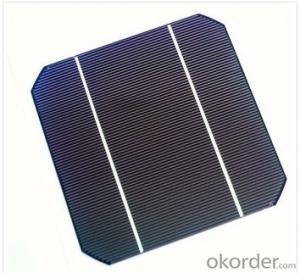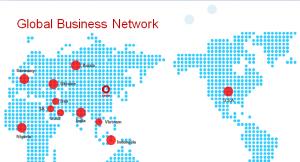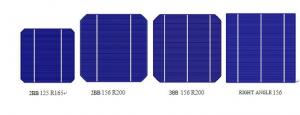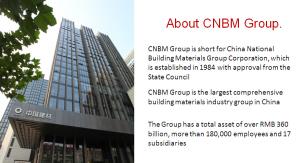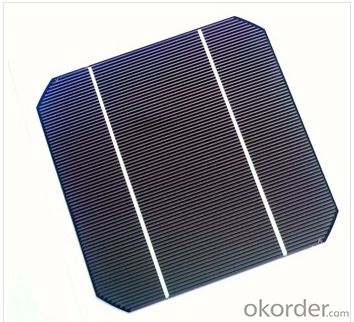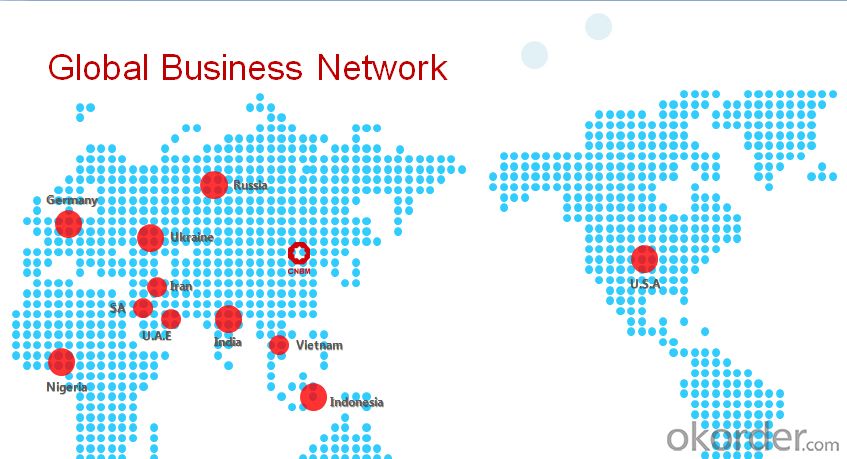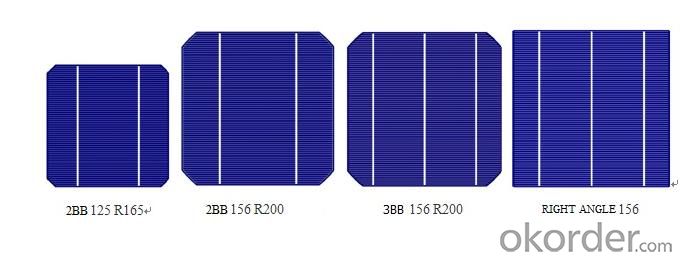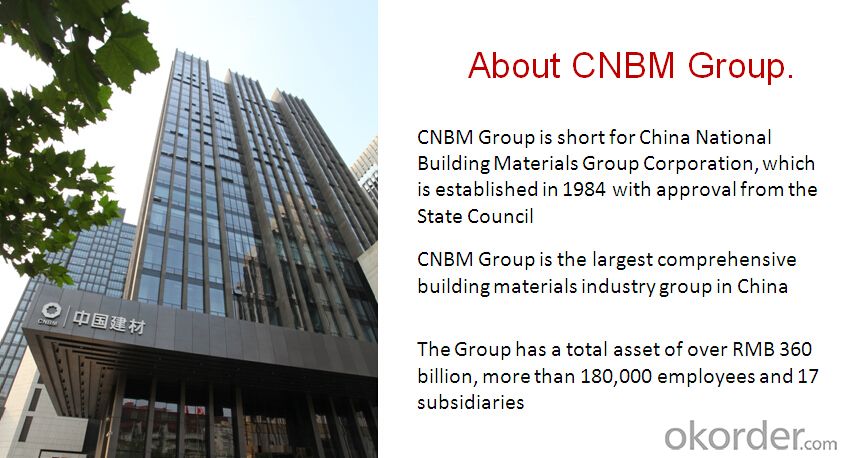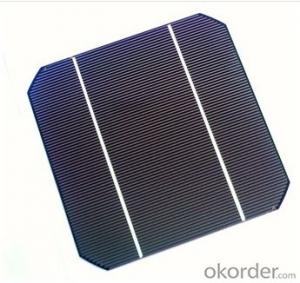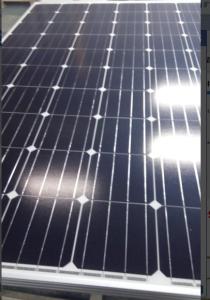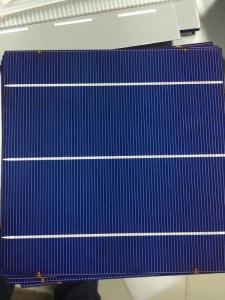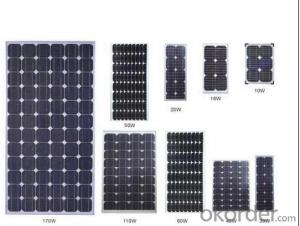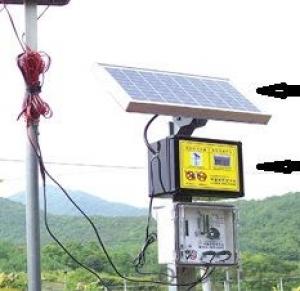Growing Solar Cells - Mono Solar Cells with Long-term Electrical Stability - CNBM - Made in China and Low Price
- Loading Port:
- Shanghai
- Payment Terms:
- TT or LC
- Min Order Qty:
- 100 PCS
- Supply Capability:
- 1000000 PCS/month
OKorder Service Pledge
OKorder Financial Service
You Might Also Like
Advantage of Mono Solar Cells
1. High efficiency and High power.
2. Long-term electrical stability.
3. Lowest price and Fastest delivery.
4. Good quality and best service.
5. Bulk supply
6. Trusted Warranty
7. Big Sale
8. More than 25 years on the lifetime.
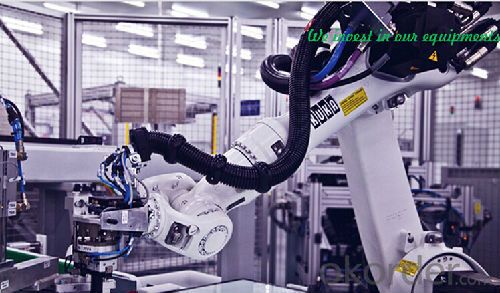
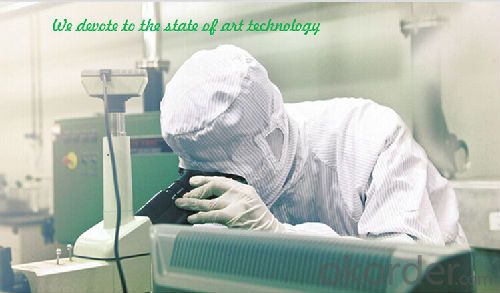
Specifications of Poly Solar Cells
Format:125 mm × 125 mm ± 0.5 mm
Thickness: 210μm ± 40 μm
Front (-):1.5mm bus bars (silver),blue anti-reflection coating (silicon nitride)
Back (+) : 2.5mm wide soldering pads (silver) back surface field (aluminium)
Temperature Coefficient of Mono Cells
Voc.Temp .coef.%/K : -0.351%/K
Isc.Temp .coef.%/K:+0.035%/K
Pm.Temp. coef.%/K: -0.47%/K
Usage and Applications of Mono Solar Cells
Solar cells are often electrically connected and encapsulated as a module. Photovoltaic modules often have a sheet of glass on the front (sun up) side, allowing light to pass while protecting the semiconductor wafers from abrasion and impact due to wind-driven debris, rain, hail, etc. Solar cells are also usually connected in series in modules, creating an additive voltage. Connecting cells in parallel will yield a higher current;our solar cells have passed IEC Certification. With high quality and stable quality. Our Cells can greatly improve the performance of Solar Modules.
Packaging & Delivery of Mono Solar Cells
Carton Box Package and Deliver by air. It should be noticed that it should be avoid of water, sunshine and moist.
Packaging & Delivery of Poly Cells
Carton Box Package and Deliver by air. It should be noticed that it should be avoid water, sunshine and moist.
FAQ:What's your products warranty?
•: No less than 90% within 10years and no less than 80% within 25years. Less power decrease.
FAQ: How many kinds of solar cells can we produce?
•: We can supply the normal 2 kinds of solar cells, Poly 156mm*156mm and Mono125mm*125mm , and the special demension also can be produced .
FAQ:What's the effeciency range of the solar cells?
•: We can supply 16.8% to 18.9% effeciency of the solar cells.
Global market trends of protectionism, which is the imposition of anti-dumping duties and require the use of local products, and other trends.
The beginning of the matter is that the US Department of Commerce against Chinese-made crystalline silicon solar cell module of anti-dumping and countervailing duty investigations, and in December 2012 ordered the anti-dumping duties. Therefore, some manufacturers are subject to up to 24 to 255 percent (calculated) rate.
Impact of this state of affairs is also extended to Europe. September 2012, the European Commission against solar cells china factory (wafers, cells and modules) initiated anti-dumping and countervailing investigations, and is scheduled to publish the findings in June.
March 2013, the EU is added to Chinese-made solar glass started anti-dumping investigation. India's Ministry of Commerce began against from mainland China, the solar cell United States, Malaysia and Taiwan anti-dumping investigation.
China did not remain silent; the Chinese government announced in May 2012, the US renewable energy industry support policies violate World Trade Organization (WTO) rules and proceedings. Chinese Ministry of Commerce in July 2012 started an anti-dumping investigation against US and South Korean manufacturing polycrystalline silicon solar cells began in September to European-made solar polysilicon anti-dumping and countervailing duty investigations.
This move made Chinese solar cell factory face greater obstacles. On the other hand, there are also allegedly by solar cell China factory began manufacturing solar cells in Taiwan and other regions, to circumvent US anti-dumping duties.
At the same time, also has been considered so far in the use of Chinese low-cost solar cell systems integrators and developers in Europe and America, it said protectionist measures will hinder the expansion of the global solar power market of the disputed.
According to the above can be considered, the global solar power market in the future will continue to be in disarray. It will also be expected to be listed weave between "six six small" and "Tier 1 & 2" level of China's major large-scale solar cell business.
After this survival of the fittest, better production techniques might survive, and a large supply of high-quality solar cells. With materials and manufacturing equipment made in China's progress, China's solar power industry will ultimately be "all Chinese made" solar power system to meet Chinese domestic demand, while export offensive launched to the global market.
- Q: What materials are commonly used in solar cells?
- Some of the commonly used materials in solar cells include silicon, cadmium telluride, copper indium gallium selenide, and perovskite.
- Q: How do solar cells handle bird droppings or other debris?
- Solar cells are designed to handle bird droppings or other debris by having a smooth and easy-to-clean surface. Additionally, regular rainfall or maintenance can help wash away any accumulated dirt or waste, ensuring optimal performance of the solar cells.
- Q: What is the impact of algae growth on solar cell performance?
- The impact of algae growth on solar cell performance is generally negative. Algae growth on the surface of solar cells can reduce their efficiency by blocking sunlight and causing shading. This reduces the amount of light that reaches the solar cells, thereby reducing their power output. Additionally, algae can also produce a biofilm that affects the surface properties of the solar cells, leading to further degradation in performance over time. Therefore, it is important to regularly clean and maintain solar panels to minimize the negative effects of algae growth.
- Q: What is the maximum voltage output of a solar cell?
- The maximum voltage output of a solar cell can vary depending on various factors such as the type and design of the solar cell, as well as the intensity of sunlight. However, for a typical silicon solar cell, the maximum voltage output is usually around 0.5 to 0.6 volts.
- Q: Can solar cells be used in boats or marine applications?
- Yes, solar cells can definitely be used in boats or marine applications. They provide a sustainable and renewable source of energy to power various systems onboard, such as navigation equipment, lighting, battery charging, and even propulsion systems. Solar panels can be installed on the deck or roof of a boat, where they can harness the sun's energy to generate electricity and reduce reliance on fossil fuels.
- Q: Can solar cells be used to power farms or agricultural operations?
- Yes, solar cells can be used to power farms or agricultural operations. Solar panels can be installed on rooftops, fields, or other suitable areas to convert sunlight into electricity. This renewable energy source can provide a consistent and sustainable power supply for various farming activities, such as irrigation systems, machinery, and storage facilities. Additionally, solar power helps reduce reliance on fossil fuels, lowers operational costs, and contributes to a greener and more environmentally friendly agricultural sector.
- Q: How to explain to students how the solar cells are made?
- The Manufacturing Process of solar cells is a bit difficult to explain, but I can send you the details through email if you want.
- Q: How do solar cells handle voltage fluctuations?
- Solar cells do not handle voltage fluctuations directly. However, to manage voltage fluctuations, additional components such as voltage regulators or inverters are used in conjunction with solar cells. These components help stabilize and regulate the voltage output from solar cells to ensure consistent and reliable power supply.
- Q: Can solar cells be used in desalination plants?
- Yes, solar cells can be used in desalination plants. Solar energy can be harnessed to power the desalination process, providing a sustainable and environmentally friendly solution to address the growing global water scarcity issue.
- Q: Can solar cells be used for powering drones?
- Yes, solar cells can be used for powering drones. Solar-powered drones utilize photovoltaic cells to convert sunlight into electricity, which can then be used to power the drone's motor and other systems. This renewable energy source allows for longer flight times and reduced reliance on traditional fuel sources.
Send your message to us
Growing Solar Cells - Mono Solar Cells with Long-term Electrical Stability - CNBM - Made in China and Low Price
- Loading Port:
- Shanghai
- Payment Terms:
- TT or LC
- Min Order Qty:
- 100 PCS
- Supply Capability:
- 1000000 PCS/month
OKorder Service Pledge
OKorder Financial Service
Similar products
Hot products
Hot Searches
Related keywords
